 A brief history of Explosive Boats
A brief history of Explosive Boats
Feedback and further info welcome.








The recent attack on a Saudi frigate off Yemen by Houti rebels using a remote controlled explosive boat brings these craft into focus. There have been a lot of different explosive boats developed over the years although few are well known. They are not only used by non-State actors and their history is actually closely intertwined with the minisubs used by Naval Special Forces. This article will give an overview of many types, with a lot of the information taken from my book Covert Shores: The Story of Naval Special Forces Missions and Mini-Subs.
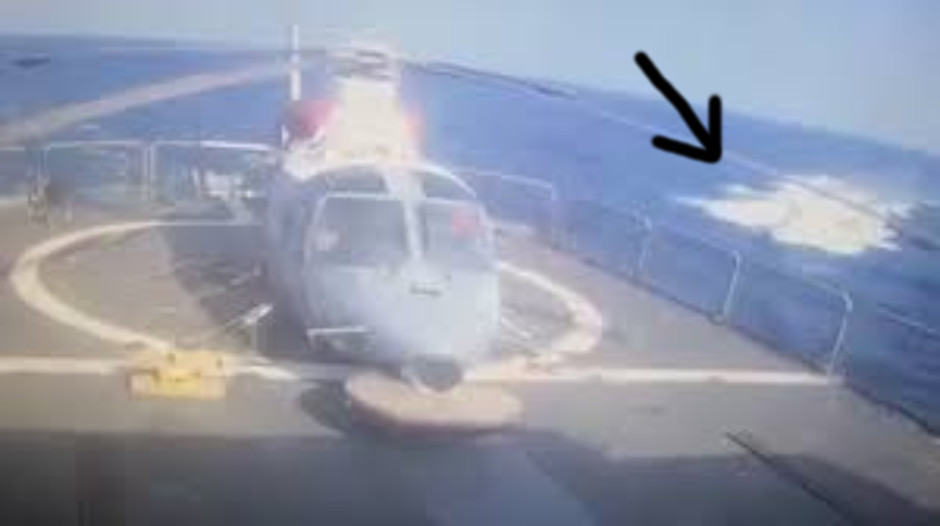
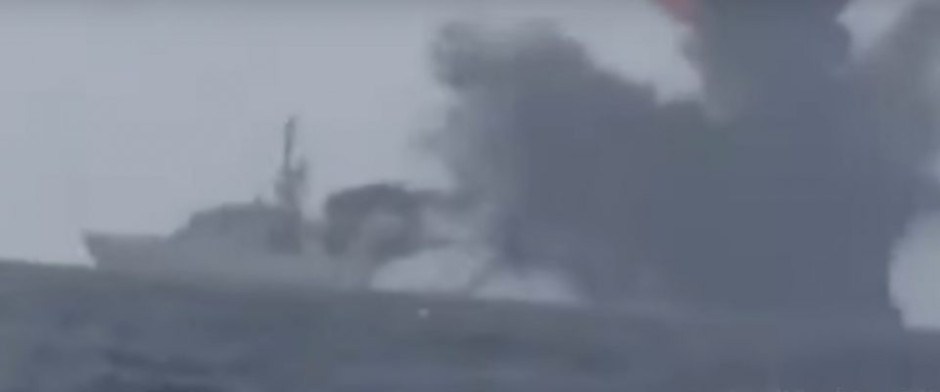
The attack on the Saudi Frigate Al Madinah (702), 30th Jan 2017.

American Civil War: CSS David
 The Confederate Navy’s CSS-David Class of explosive boats were semi-submersible craft that flooded ballast tanks in order to lower its profile. The first craft was built in 1863 by St. Julien Ravenel, and named the David in reference to David and Goliath, and described as a “torpedo boat”. This was because they used a 134lb (60kg) warhead mounted on a long spar from the front of the boat. The term ‘torpedo’ really just meant an explosive charge used against ships and the self-propelled ‘torpedoes’ we know today were not even invented until a few years later.
The Confederate Navy’s CSS-David Class of explosive boats were semi-submersible craft that flooded ballast tanks in order to lower its profile. The first craft was built in 1863 by St. Julien Ravenel, and named the David in reference to David and Goliath, and described as a “torpedo boat”. This was because they used a 134lb (60kg) warhead mounted on a long spar from the front of the boat. The term ‘torpedo’ really just meant an explosive charge used against ships and the self-propelled ‘torpedoes’ we know today were not even invented until a few years later.

The Davids had a generally cylindrical hull with conical ends with a single screw was mounted in the tail. They had a steam boiler towards the front with a large chimney and inlets sticking up in the air. To reduce their visual signature the furness burnt smokeless fuel. Behind this was an open cockpit for the four-man crew. The craft was about 50ft (15m) long without the warhead spar, which added another 10ft (3m). The spar hinged at its base and could be lifted by pulleys from within the craft, a vital safety consideration when you think about it.
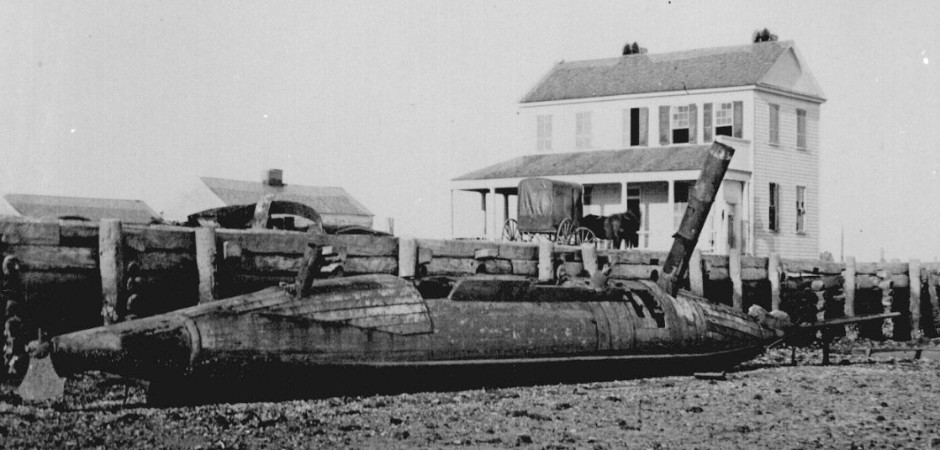
A David Class torpedo boat
The mission profile was to attack at night while running awash, and ram the target at high speed. The speed of the impact allows the warhead to be embedded in the target, where it is released from the attacking craft and detonated after the craft has backed off to a safe distance. Detonation was generally by means of a rope attached to a spring-loaded trigger, although there is some evidence that some may have been electrically triggered. In practice this arrangement was quite credible and a famous and generally successful attack was made on the Union warship USS New Ironsides on the night of 5th October 1863.
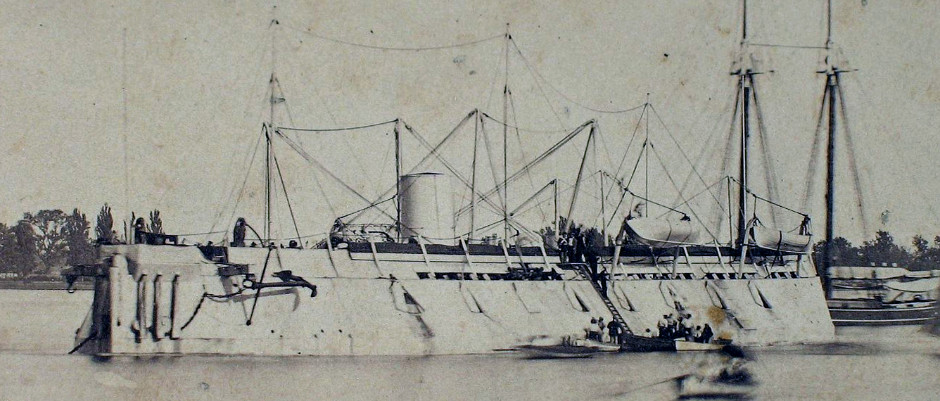
USS New Ironsides
The David approached its Goliath as she lay at anchor, the low silhouette and use of smokeless fuel allowed the David to get within 50 yards (45m) before being detected. Within seconds the David rammed the charge into the ironclad and backed off before triggering the explosives.
That much had gone to plan, but the explosion created a large water plume which came down on the David and went down the funnel, putting her steam boiler out. More water bucketed into the hull via the open top of the pilot station. Fearing she was sinking some of her crew abandoned ship, but the engineer who could not swim remained aboard awaiting his fate. When it became apparent that she was not going to sink, some crew reboarded her, managed to relight her boiler and made their escape, leaving a few stranded colleagues to be captured.
Several more David-class torpedo boats were built, with some being twice as long, and one or two even three-times as long as the original. The sister ships did not repeat the David’s success but their existence proved a menace for the Union Navy. As well as being a precursor to more recent Special Forces semi-submersibles, the David design of spar torpedo boats was also a precursor to explosive motorboats.
Get The essential guide to World Submarines
This Covert Shores Recognition Guide Covers over 80 classes of submarines including all types currently in service with World Navies.Check it out on Amazon
World War One: Fernlenkboot
 As has come to be expected, Germany’s first outing into unconventional sneak attack emphasized scientific advancement over improvisation. The Fernlenkboot was a remotely controlled (in 1915!) explosive boat designed to break the British naval blockade without risking the lives of the country’s sailors.
As has come to be expected, Germany’s first outing into unconventional sneak attack emphasized scientific advancement over improvisation. The Fernlenkboot was a remotely controlled (in 1915!) explosive boat designed to break the British naval blockade without risking the lives of the country’s sailors.

It was a 13m (43ft) motorboat with a beautifully crafted streamlined form concealing a massive 700kg (1,500lb) charge and two 210hp Maybach gasoline engines notrmally used for Zepplins, giving it an incredible 30 knot top speed.
The concept was to launch the boat in the direction of the target from the shore with a length of cable attached down which electronic signals could be sent to control speed and heading, in effect steering the boat on to the target. This worked well during testing but the distance at which the command post could accurately steer onto the target was too limited so, amazingly, an aircraft was added to the equation to act as a spotter and guide. The aircraft communicated with the shore station by wireless radio, and the shore station commanded the boat by wire.
Only one attack was at all successful, with FL-12 (the twelfth of seventeen Fernlenkboote built) attacking the monitor HMS Erebus on 28th October 1917 off Flanders. Erebus was an incredibly heavily armored ship and took the blow on the chin, losing some of her four-foot thick armored belt but not being seriously damaged.
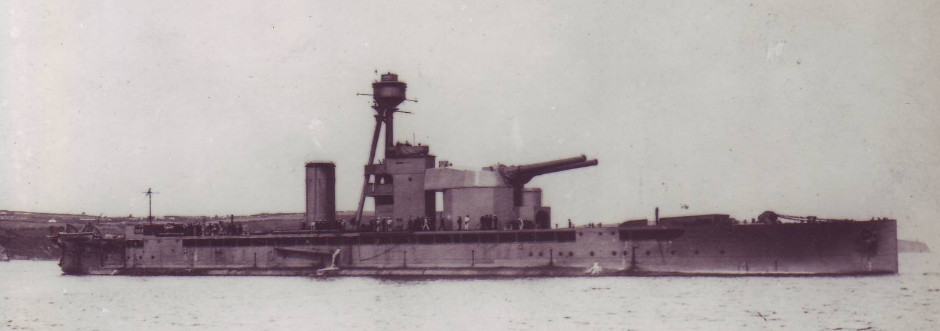
HMS Erebus
Viewed from the German standpoint the Fernlenkboot was an expensive and difficult weapon to apply and the program was abandoned in 1918. History may view the Fernlenkboot more favorably, at least in the sense of its technology and ingenuity.
The ultimate book of Special Forces subs Covert Shores 2nd Edition is the ONLY world history of naval Special Forces, their missions and their specialist vehicles. SEALs, SBS, COMSUBIN, Sh-13, Spetsnaz, Kampfschwimmers, Commando Hubert, 4RR and many more.
Check it out on Amazon
World War Two: MT explosive boat
 Italy’s elite Special Forces unit, Decima MAS (aka X-MAS) Motoscafo da Turismo (‘Tourist Motorboat’, often abbreviated to MT) was an exploding motorboat which rammed its targets like a US Civil War torpedo-ram. It was more affectionately called the Barchino meaning ‘little boat’ by the men who used it. It was first developed in the 1930s and put to use in World War Two.
Italy’s elite Special Forces unit, Decima MAS (aka X-MAS) Motoscafo da Turismo (‘Tourist Motorboat’, often abbreviated to MT) was an exploding motorboat which rammed its targets like a US Civil War torpedo-ram. It was more affectionately called the Barchino meaning ‘little boat’ by the men who used it. It was first developed in the 1930s and put to use in World War Two.
It was the first ‘modern’ explosive boat, the one to which most subsequent designs can trace their lineage. The concept was incredibly simple; you take a fast motor launch, place a large warhead in the nose and drive it at full speed into an enemy ship. The pilot escapes just before impact.
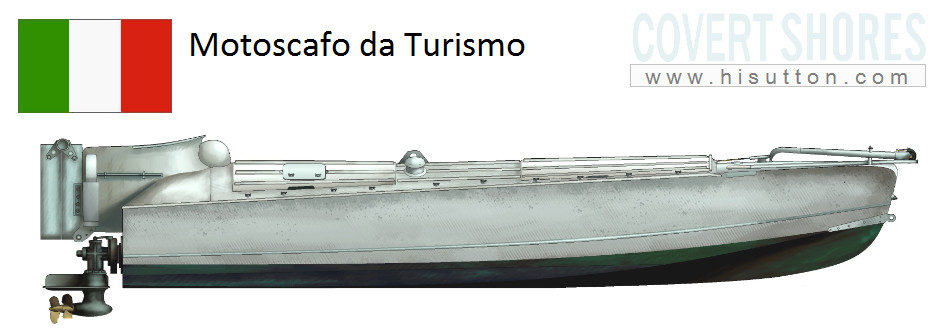
It was 5.6m (18ft) long and 1.6m (5.2ft) wide, but powered by a 95hp Alfa Romeo AR outboard motor allowing an impressive speed of 33kt at full load. The engine drove a contra-rotating propeller mounted on a double-right-angle joint that hung below and behind the boat, which was steerable and also acted as the rudder. A very interesting feature of the propeller was that it could be swiveled up to starboard (right) so that it no longer protruded below the craft. This allowed the boat to scrape over the top of typical torpedo net defenses. This could be done either at full speed, using the momentum to carry the boat over with barely any decrease in speed whilst the propeller was tucked in, or by slowly and quietly easing over the net to maintain the element of surprise.
It carried a 300kg (660lb) barrel-shaped warhead that was mounted low down inside the hull towards the bow. The bow was rimmed with a fender that was designed to split the boat down the middle from a frontal-aspect impact, thus releasing the warhead which could be set to detonate on impact (i.e. at or above the waterline) or at a depth as it sank below the waterline.

The pilot sat in the extreme rear of the craft overhanging the stern. A short distance from impact, maybe just 50m (164ft) the pilot would be jettisoned off the back of the craft thus avoiding a sudden demise. He was equipped with a life-vest or floatation device which doubled as a backrest.
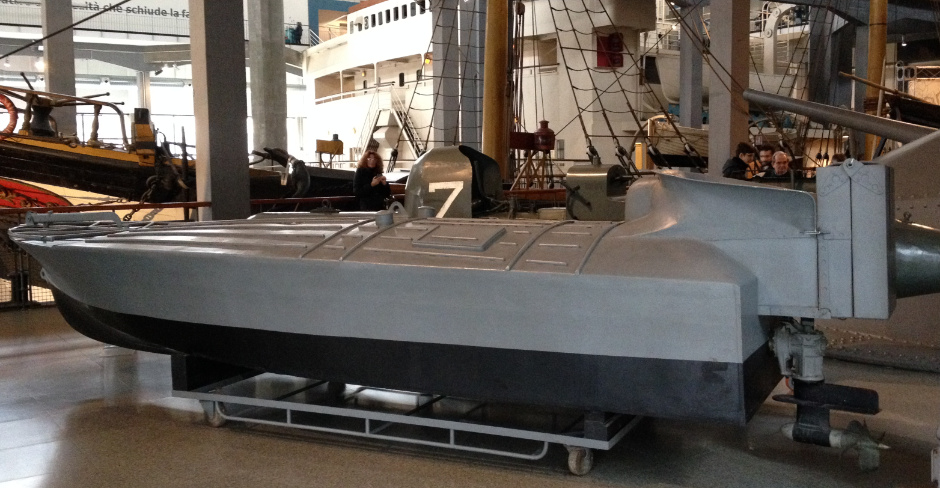
An MT on display in Milan
On 25th March 1941, two Italian destroyers, the Francesco Crispi and Quintino Sella, departed the Italian base on Leros, an island in the Aegean Sea, with three MTs each carried on davits. Their target was British shipping in Souda Bay on the Northwestern coast of Crete, in the eastern Mediterranean. At 0330hrs on 26th the destroyers stopped to launch the MTs about 10 miles (16km) northeast of the harbor entrance. There was a heavy haze providing good cover but this also made visual navigation difficult. Sunrise would occur at 0518hrs giving the MTs less than 1.5 hours to attack their targets.
The boats cruised together in formation towards their unsuspecting prey. Ahead of them were three layers of boom defenses consisting of floating nets. With the swiveling propeller drives, the MTs made it over these without incident, and did not encounter any boom defense vessels. Two boats aimed for the largest warship in sight, the heavy cruiser HMS York. At 0446hrs the first pilot pulled the lever that would set the MT on a collision course with the cruiser, simultaneously jettisoning him off the back of the craft. The MT continued at full throttle into the cruiser, impacting amidships with a massive explosion. The second boat followed shortly afterwards, also impacting amidships. Both boiler rooms and an engine room quickly flooded and the warship started to sink. Another MT hit the oiler Pericles, sinking it quickly.
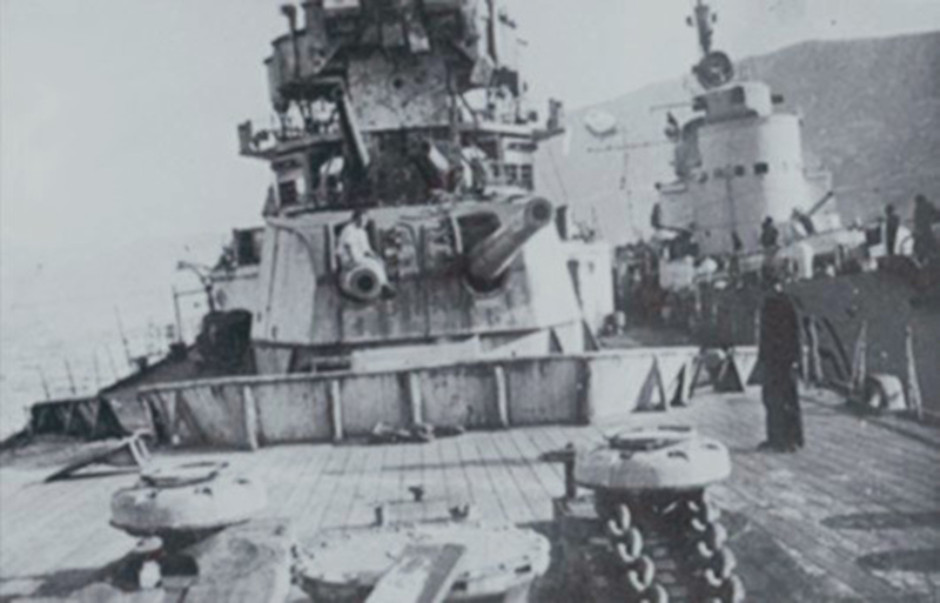
HMS York after the attack
There are varying accounts of the other three MTs, sometimes suggesting that two more merchant ships were damaged. For sure, at least one MT missed any targets and wound up beached. HMS York was seriously damaged and had to be towed onto the beach to prevent her sinking outright, and she was eventually abandoned. In the confusion of war, the German Luftwaffe claimed to have sunk the cruiser but both the Italians and British knew differently. All six Decima-MAS men were captured, but overall the mission can be regarded as an outright success for Decima-MAS. MTs were subsequently used in several missions.
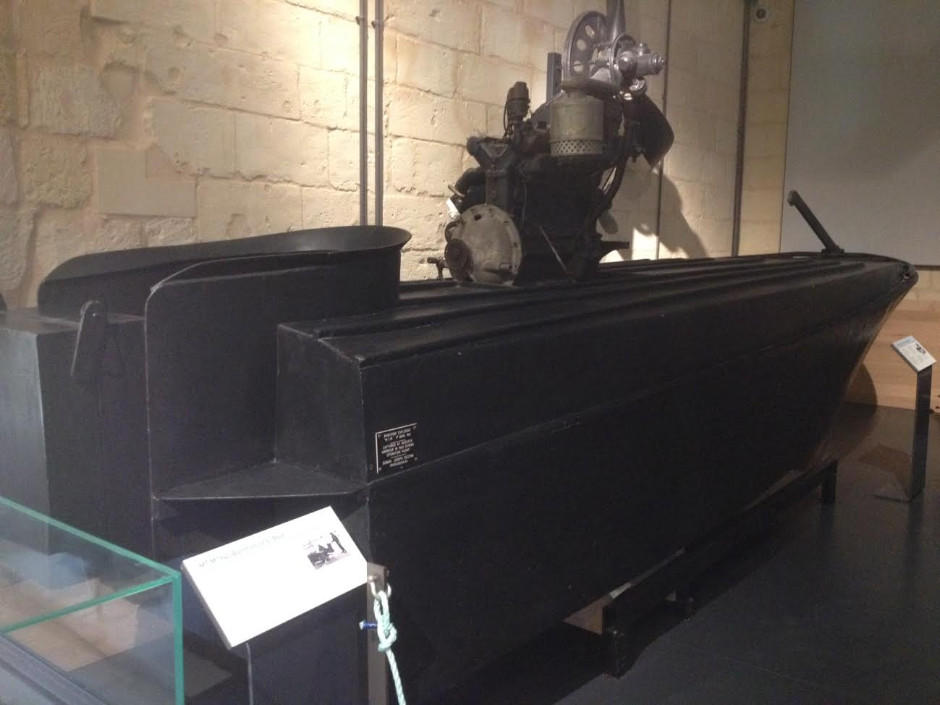
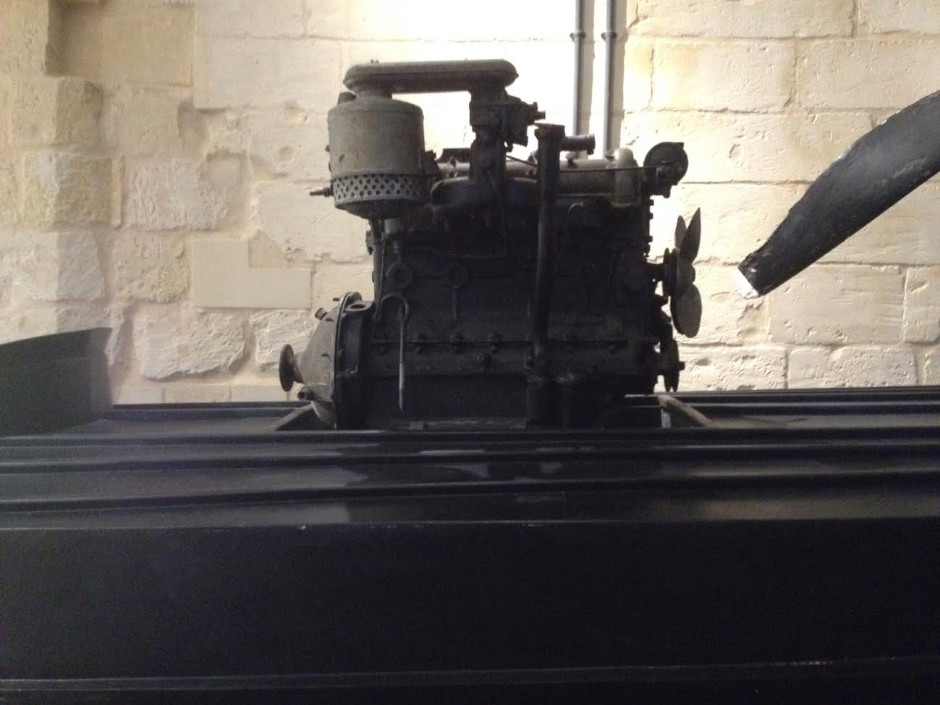
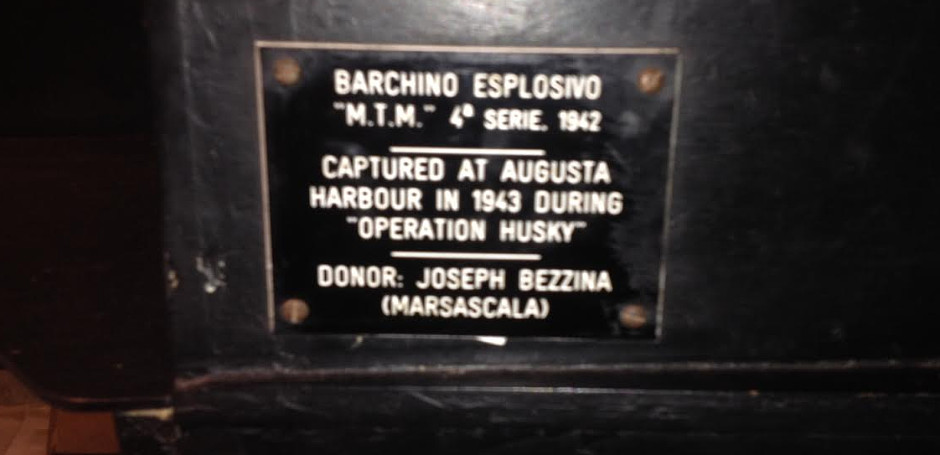
An MT on display at St Elmo's fort, Valletta, Malta.
World War Two: Boom Patrol Boat
 By mid-1943 the British copy of the Italian MT was entering testing. Like many things involved in British Special Forces at the time it was deliberately deceptively named, hence ‘Boom Patrol Boat’. The RAF termed it the Skylark. It was operated by the ‘Royal Marines Boom Patrol Detachment’ who can be thought of as the main father unit of today’s Special Boat Service (SBS).
By mid-1943 the British copy of the Italian MT was entering testing. Like many things involved in British Special Forces at the time it was deliberately deceptively named, hence ‘Boom Patrol Boat’. The RAF termed it the Skylark. It was operated by the ‘Royal Marines Boom Patrol Detachment’ who can be thought of as the main father unit of today’s Special Boat Service (SBS).

Although different in every detail, the connection to the Italian design was unmistakable. The RMBPD’s thinking evolved into a combined attack force using canoes to covertly make a route through the nets, and then a full speed approach by the explosive boat. The canoe would then be used to recover the BPB pilot.
Development began with an air-dropped design which would be delivered to the target by Lancaster bomber. The result was a slightly smaller boat with a compartment amidships for the pilot to crouch in whilst the boat was parachuted from the aircraft flying at 145mph at an altitude of 800ft. The bomber pilot lined up with the target, flying into the wind and actually flew over the target before releasing the boat, which drifted backwards over the target into the water where the BPB pilot, if he hadn’t been shot to pieces by the flak, hopped out of his cubby hole and into the cockpit at the extreme rear of the craft. With the parachutes jettisoned, the boat would race at the target at up to 40kt, with the pilot abandoning it in the same manner as the Italian design. With the air-drop method, the air force gave the BPB 50% chances of hitting the water in a satisfactory state (ignoring, for the moment, the chances of the boat being shot at as it drifts down by parachute). Live tests were done with RMBPD men and fortunately no men were lost, but it was all incredibly dangerous. Missions were planned for the Norwegian Theater but they were cancelled due to outside factors and the BPB has never received the attention it deserved. It was never used operationally.
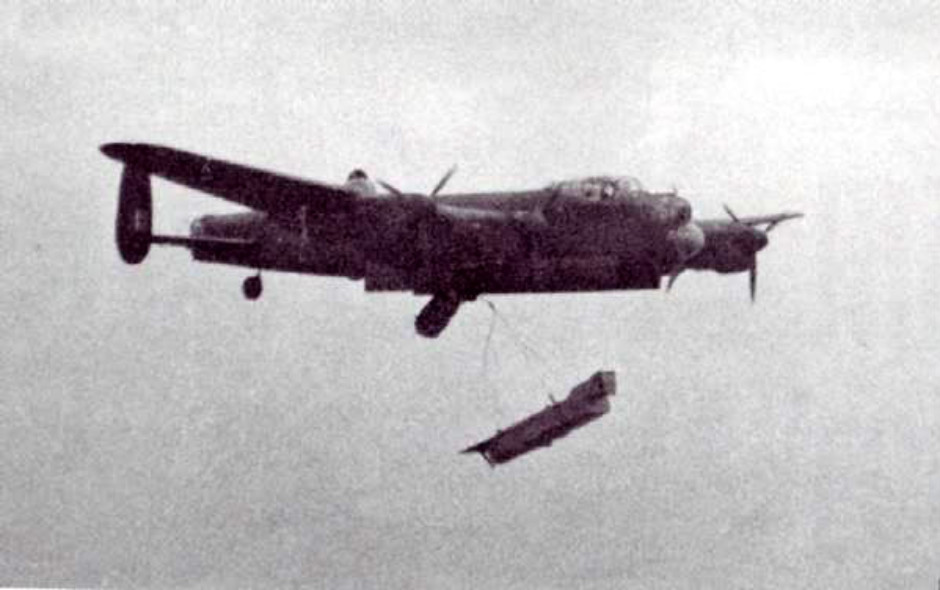
A BPB being dropped from a Lancaster bomber of the famous 617 'Damnbusters' sqd. RAF. The boat's pilot is inside it.
World War Two: Linse
 The German equivalent to the MT explosive boat was the Linse sprengboot (lentil blasting boat) which was slightly smaller and a more basic design. The pilot sat fully exposed amidships between the explosives and the 3.6l car engine which drove a single nonretracting propeller at the rear, meaning that in order to abandon ship he had to stand up and jump over the side.
The German equivalent to the MT explosive boat was the Linse sprengboot (lentil blasting boat) which was slightly smaller and a more basic design. The pilot sat fully exposed amidships between the explosives and the 3.6l car engine which drove a single nonretracting propeller at the rear, meaning that in order to abandon ship he had to stand up and jump over the side.
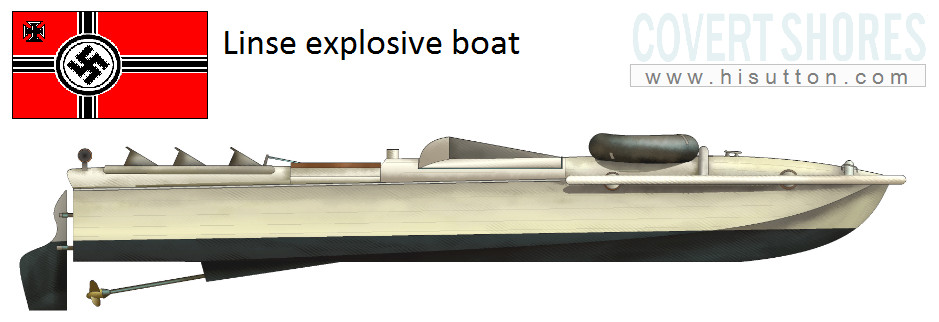
A significant advancement over other explosive boats was that once abandoned, the Linse could be guided to its target via remote control from a control boat which would also pick up the pilot. This aspect of the design harked back to the Fernlenkboot of the First World War.
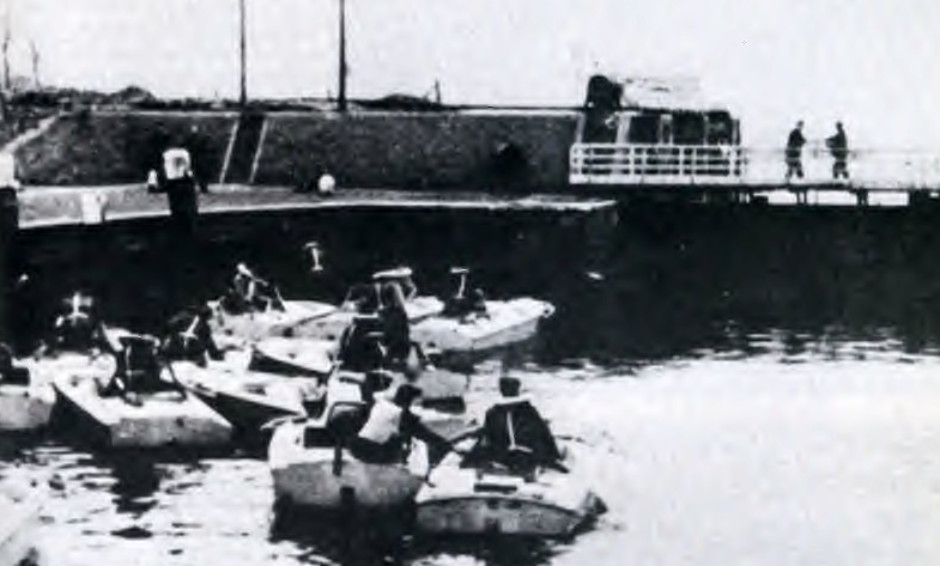
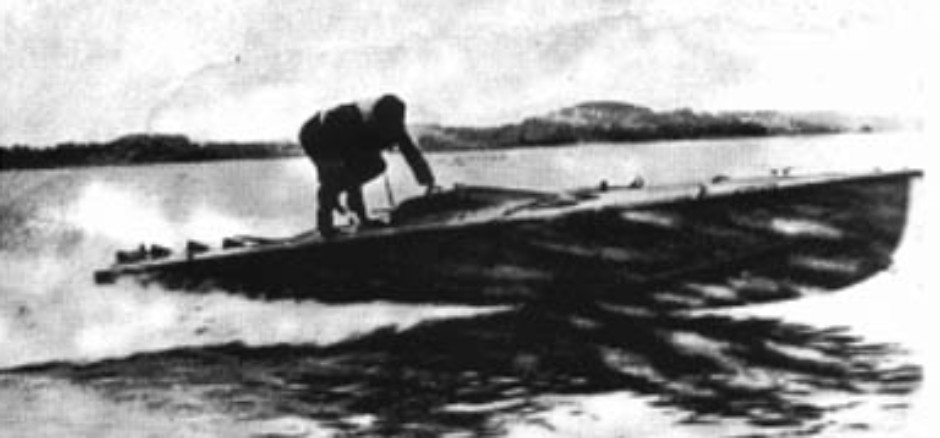
The type was used in some operations but never with any notable successes. They were barely seaworthy and casualties were high.
World War Two: Shinyo & Maru-ni
 Japan deployed two main types of explosive boat, the Navy’s Shinyo (Sea Quake) and the Army’s Maru-ni. The Navy’s boat was a suicide device where the pilot was expected to ram the target whilst the Army’s type was, at least on paper, a hit and run weapon using a depth charge with a four second fuse. In the latter case the chances of survival were slim and it was in practice a kamikaze weapon.
Japan deployed two main types of explosive boat, the Navy’s Shinyo (Sea Quake) and the Army’s Maru-ni. The Navy’s boat was a suicide device where the pilot was expected to ram the target whilst the Army’s type was, at least on paper, a hit and run weapon using a depth charge with a four second fuse. In the latter case the chances of survival were slim and it was in practice a kamikaze weapon.
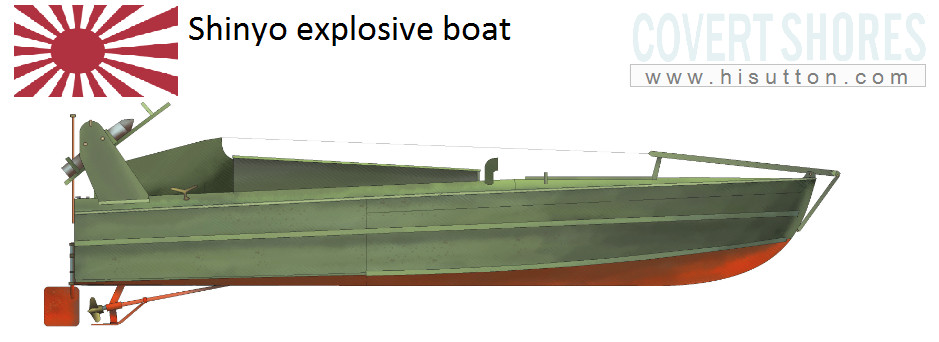
Both types were of simple wooden construction (to save steel) with a charge in the forward hull with a simple frame to transfer the impact to the detonator, the engine centrally mounted with a fixed propeller running aft beneath the hull and an open crew position aft. Speed was less impressive than their European equivalents at just 18kt with the warhead installed but achieved a last-minute boost from two 120mm RO-SO rockets mounted on either side of the cockpit.
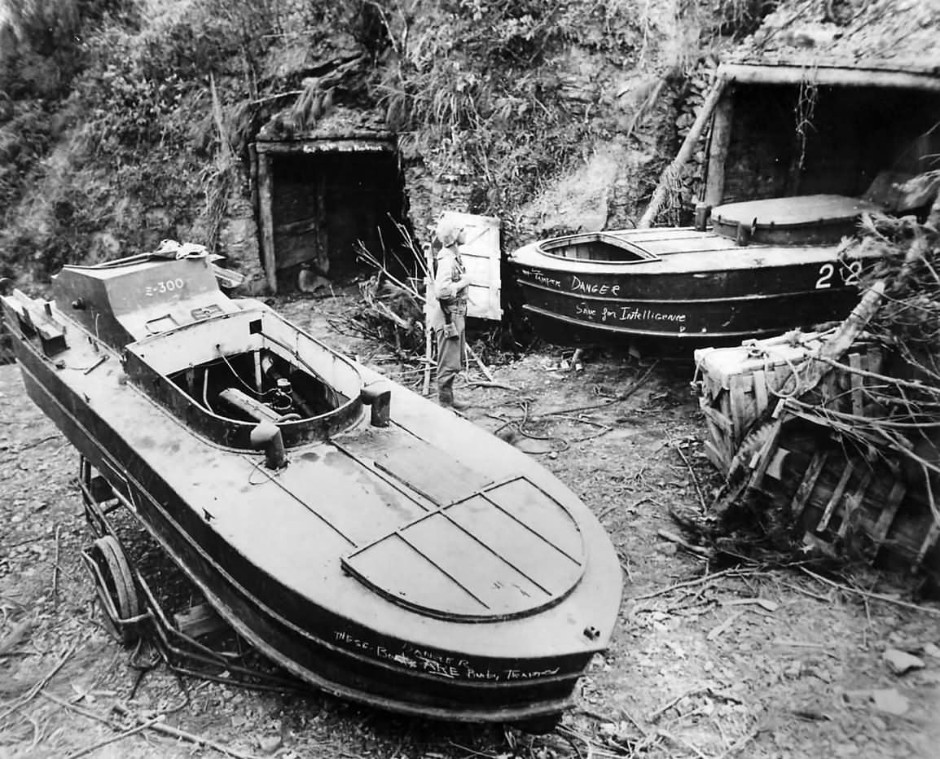
Shinyo
The Shinyo was tested in the summer of 1944 and rushed into production with the first units be deployed with minimal training in September 1944. Although the craft had similarities to the Italian MT explosive boat the organization was nothing like it; units had a standard complement of 55 explosive boats (one had 68 and later units only 25) and about 190 people and pilots received just three months training. The modus operandi was for the explosive boats to be hidden in caves or tunnels and launched into the water on rails, from where they’d assemble en-masse just off the flank of the invading force. They would then attack as a swarm, thus maximizing their chances of overwhelming the enemy. Bringing up the rear of the flotilla would be the two-man command boats (Shinyo Type-5) which would observe the attack and give supporting fire using a 13.2mm heavy machinegun before commencing its own kamikaze attack. Planners expected about 10% of the craft to hit their targets, but in the face of defensive fire, the results were much lower with only nine US vessels succumbing to them with the largest being the USS Hutchins, a 2,000 ton destroyer which was damaged on 27th April 1945.

USS Hutchins
There were attempts to build more effective suicide boats including the Shinyo Type-2 with hydrofoils, the Type 6 with a large liquid-fuelled rocket as is only means of propulsion and the Type-7 with no less than twelve rockets for propulsion. These rocket-powered types boasted 70kt but would have lacked endurance. They were never to enter service. The final type was the Type-8 which amounted to a tiny torpedo boat with three crew and two torpedoes. Again it did not reach service before the end of the war.
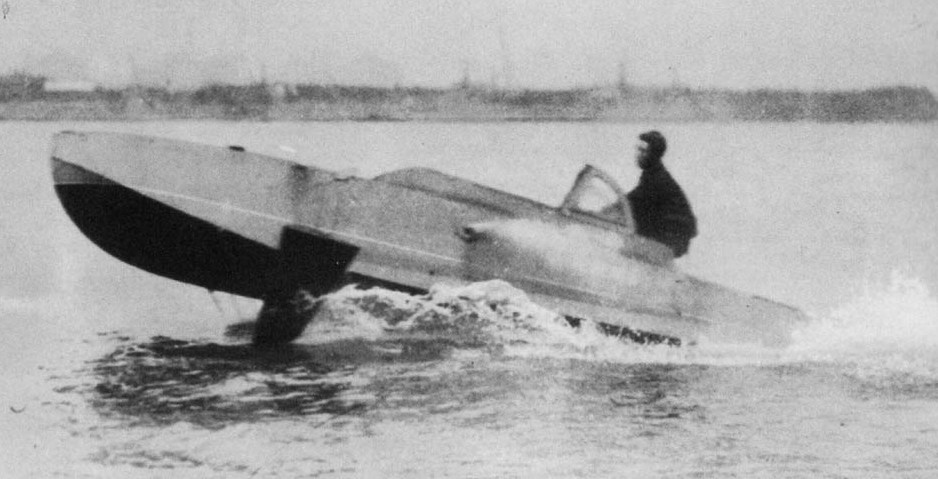

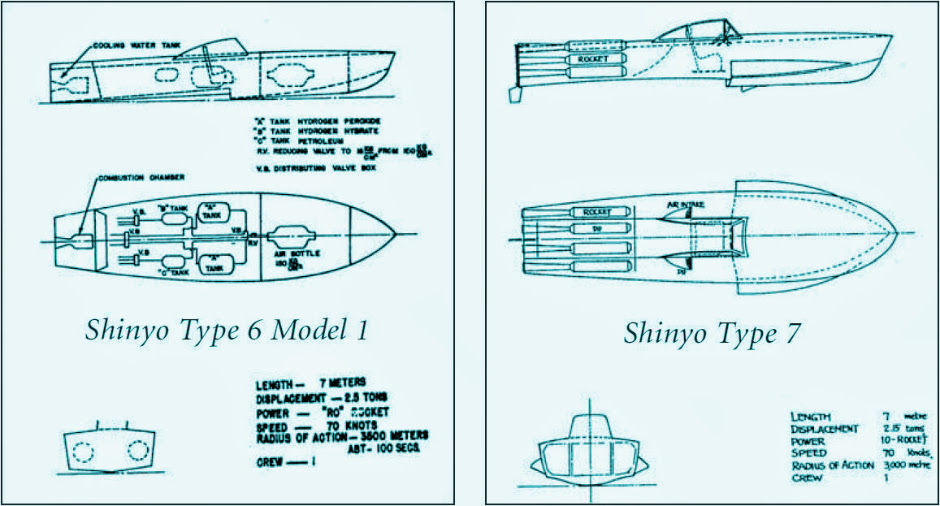
Yom Kippur: Patzchan
 Immediately after World War Two Israel acquired several second-hand MT explosive boats from Italy. On 22nd October 1948 one was used to sink the Egyptian armed yacht Emir Farouk. The MTs were still on hand in the 1960s but had been adapted as Special Forces transports and were no longer operational by the 1970s.
Immediately after World War Two Israel acquired several second-hand MT explosive boats from Italy. On 22nd October 1948 one was used to sink the Egyptian armed yacht Emir Farouk. The MTs were still on hand in the 1960s but had been adapted as Special Forces transports and were no longer operational by the 1970s.
So in 1969 Israeli Naval Special Forces (S13) developed a replacement: The Patzchan (hawfinch). It was essentially a Snunit fast assault boat with a 270kg (600lb) explosive charge in the bow. Compared to the older Italian MT explosive boats they were much larger but correspondingly had better seakeeping. Because the engines were in the back the pilot’s position had to be raised so that he could escape over the stern as the craft made its terminal charge. The tactic devised called for the Patzchan to run in towards the target behind a Snunit which would illuminate the target with hand flares and then turn sharply so that the Patzchan was suddenly revealed. At a few hundred meters from the target the pilot would lock the steering and eject off the back using a brake-chute to ensure he clears the stern. The Snunit would circle to pick him up and make the escape. The approach emphasized audacity rather than stealth but even if they missed the missile boats the large explosion would send a clear message to the enemy that the anchorage was not safe.

Late on the night of 17th October 1973 the two Patzchans, led by their Snunit motherships, set off to attack the Egyptian missile boat base at Hurghada. Using bulky 1st generation passive infrared goggles the commander surveyed the anchorage, identifying the protruding bow of a missile boat previously sunk by S13’s frogmen, and another active one moored to the dock slightly off to the left. Even at these short ranges, in the darkness they still had the element of surprise. The first team accelerated with the Snunit leading and the Patzchan close behind, its view obscured by the boat in front. The Snunit launched a flare so that the explosive boat would be able to see its target a sit swung off to one side, but that plopped into the water. Unable to distinguish the target the Patzchan also swung around for a second pass. The duff flare had however alerted a nervous enemy and immediately all hell broke loose. Amid the hail of bullets the pair began their second run. Again the flare did not work as planned but this time, using dead reckoning the Patzchan’s pilot aimed the boat, locked the steering and initiated the ejection. As he slid smoothly off the back of the craft he watched as the boat charged in the direction of the pier. Suddenly it turned sharply and started running in a wide circle; something had gone wrong with the steering. Given the volume of fire it is possible that it had been hit by a lucky shot. The first Snunit picked up the pilot and rejoined the others to act as the guide again for the second Patzchan. Yet again the illumination trick failed so the pilot aimed his explosive boat at the pier and ejected. There was a massive explosion and many of the defender’s guns fell silent. As the attacking force extracted themselves they saw the other Patzchan explode, although the exact location could only be guessed at. Despite failing to hit the missile boat the mission was considered a partial success as it had caused a massive explosion within the heart of the enemy base, reminding the Egyptians of the vulnerability of their strategically important missile boats.
Get The essential guide to World Submarines
This Covert Shores Recognition Guide Covers over 80 classes of submarines including all types currently in service with World Navies.Check it out on Amazon
Balkans War
 During Croatia’s war for independence from Yugoslavia, engineers and commandos from the elite 82nd Maritime Unit devised several ways to attack Yugoslav Navy vessels. A remote control explosive boat using hydrofoils was designed but never built.
During Croatia’s war for independence from Yugoslavia, engineers and commandos from the elite 82nd Maritime Unit devised several ways to attack Yugoslav Navy vessels. A remote control explosive boat using hydrofoils was designed but never built.
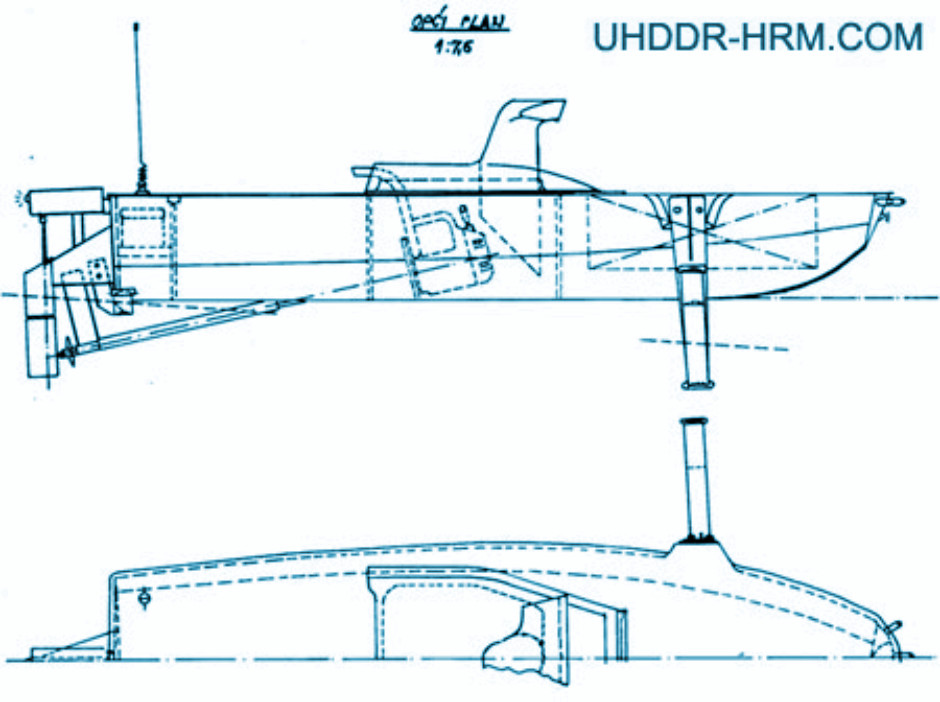
Iran
 Iran has fielded a range of explosive boats since the Iran-Iraq war. There are suggestions that the Houthi remote control explosive boat was Iranian in origin.
Iran has fielded a range of explosive boats since the Iran-Iraq war. There are suggestions that the Houthi remote control explosive boat was Iranian in origin.
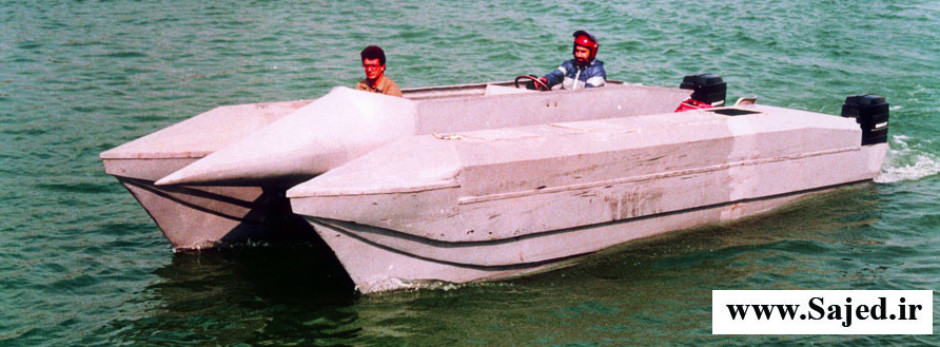
This picture from the Iran-Iraq war appears to show a catamaran explosive boat being tested. Via Galen Wright, Twitter
Some Iranian explosive boats use a jet ski to allow the pilot to escape. The pilot is sitting on the jet ski at the stern of the explosive boat. Once he has aimed the explosive boat at the target, he locks the steering and pulls a lever to jettison himself off the back of the boat on the jet ski, thus making his escape.

Tamil Tigers
The Liberation Tigers of Tamil Eelam (LTTE - popularly known as the Tamil Tigers) waged a bloody civil war with the Sri Lankan government from 1983 until 2009. At times they dominated much of the north of the country and developed a sizable military capability. They were eventually defeated militarily in 2009.
 Main article on LTTE Sea Tigers' sneak craft and midget subs
Main article on LTTE Sea Tigers' sneak craft and midget subs
The Sea Tigers’ gunboats had a very limited capability when it came to sinking larger vessels. The answer, as they saw it, lay in making the boat into a torpedo. The one thing that the LTTE possessed was fighters willing to die for their cause, even if it meant suicide. Thus suicide craft with a warhead attached to the front, rammed into an enemy vessel, was a very real tactic.
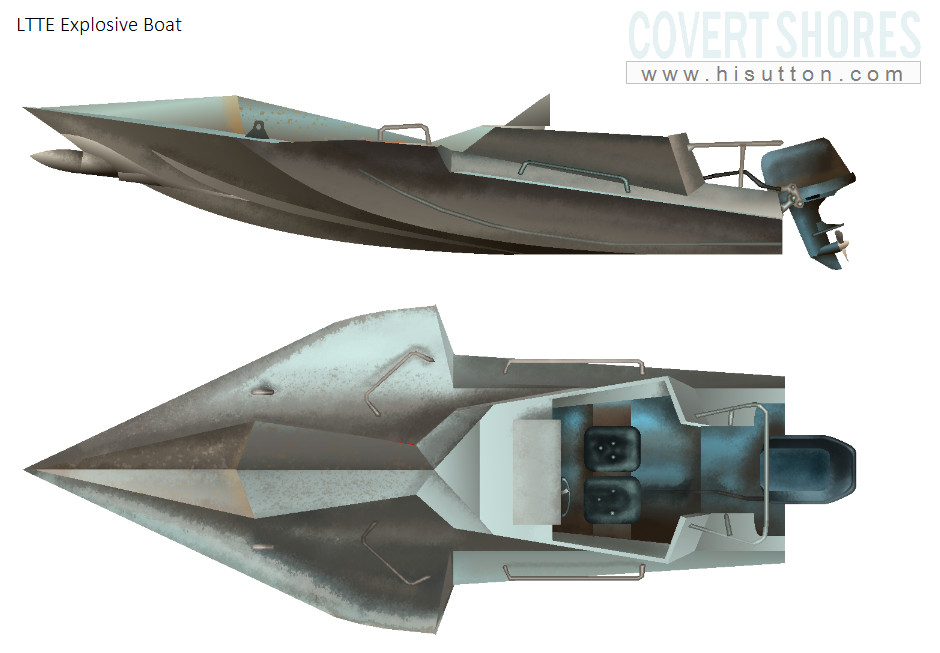
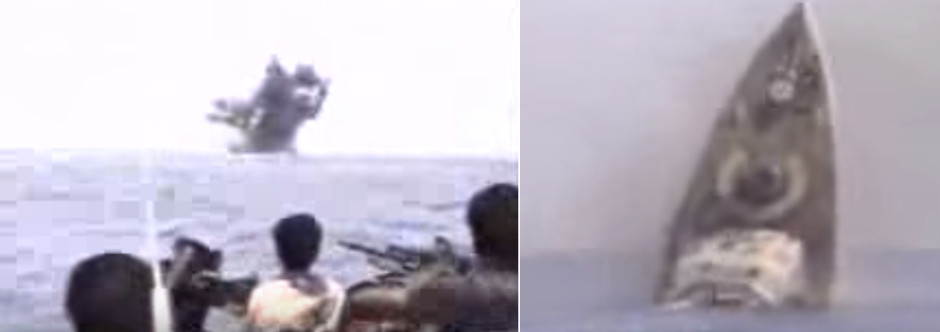
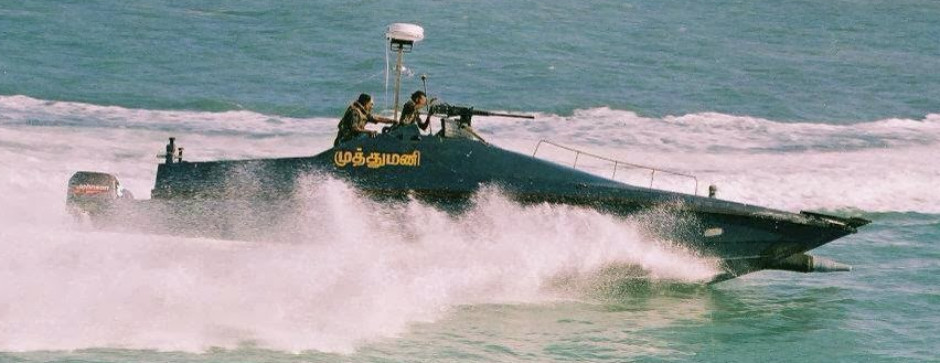
Related articles (Full index of popular Covert Shores articles)


 CCH (Combat Craft Heavy) SEALION and Alligator Semi-Submersible Boats. w/Cutaway
CCH (Combat Craft Heavy) SEALION and Alligator Semi-Submersible Boats. w/Cutaway
 Armored Stealth Boat used for car smuggling by Chinese organized crime
Armored Stealth Boat used for car smuggling by Chinese organized crime
 Narco Subs 101
Narco Subs 101
 LTTE Sea Tigers' sneak craft and midget subs
LTTE Sea Tigers' sneak craft and midget subs




 World survey of Special Operations Craft
World survey of Special Operations Craft

 WP-18 Tactical Strike Craft
WP-18 Tactical Strike Craft

 Styx riverine Special Forces craft
Styx riverine Special Forces craft

 Barracuda Special Forces interceptors
Barracuda Special Forces interceptors
 Special Forces Jet Skis
Special Forces Jet Skis

 North Korean Very Slender Vessels (VSVs)
North Korean Very Slender Vessels (VSVs)


